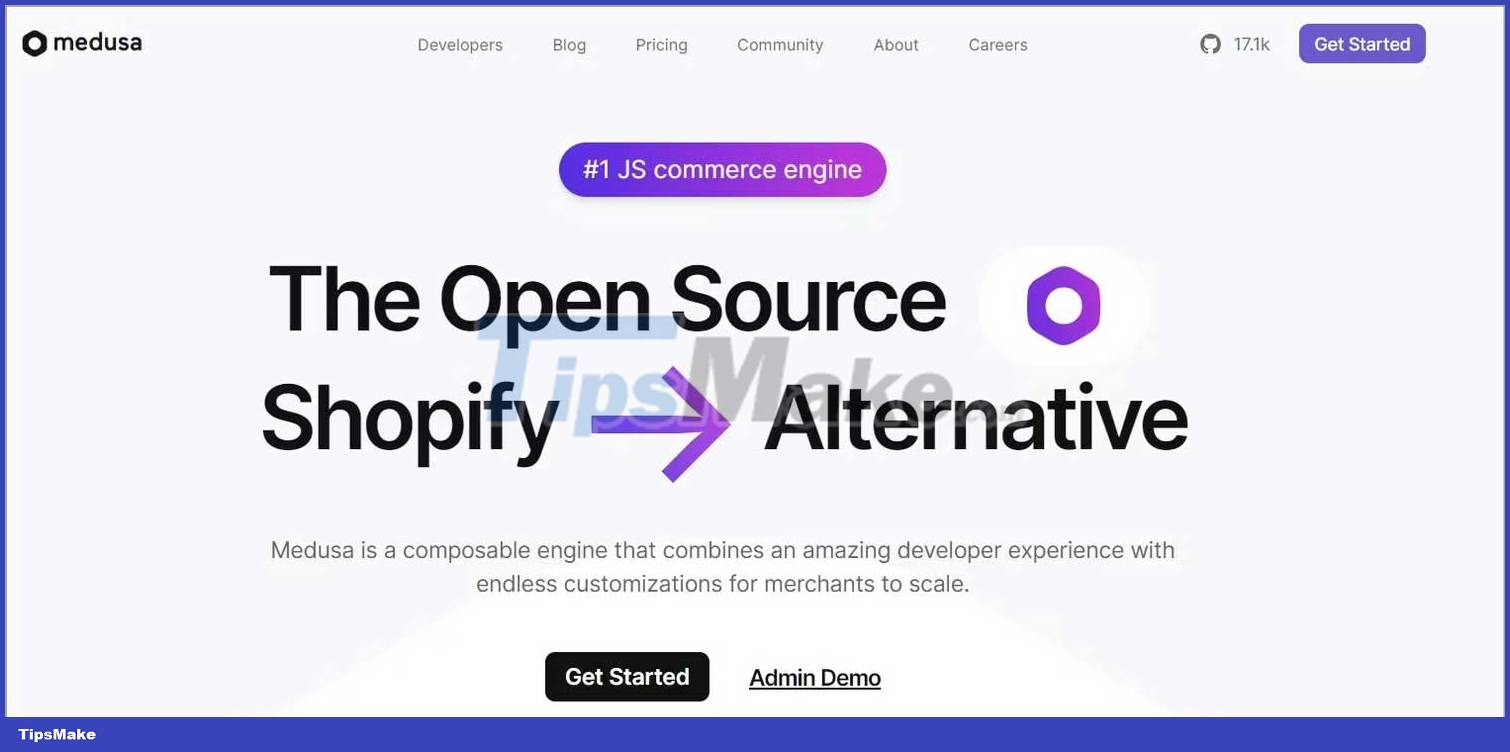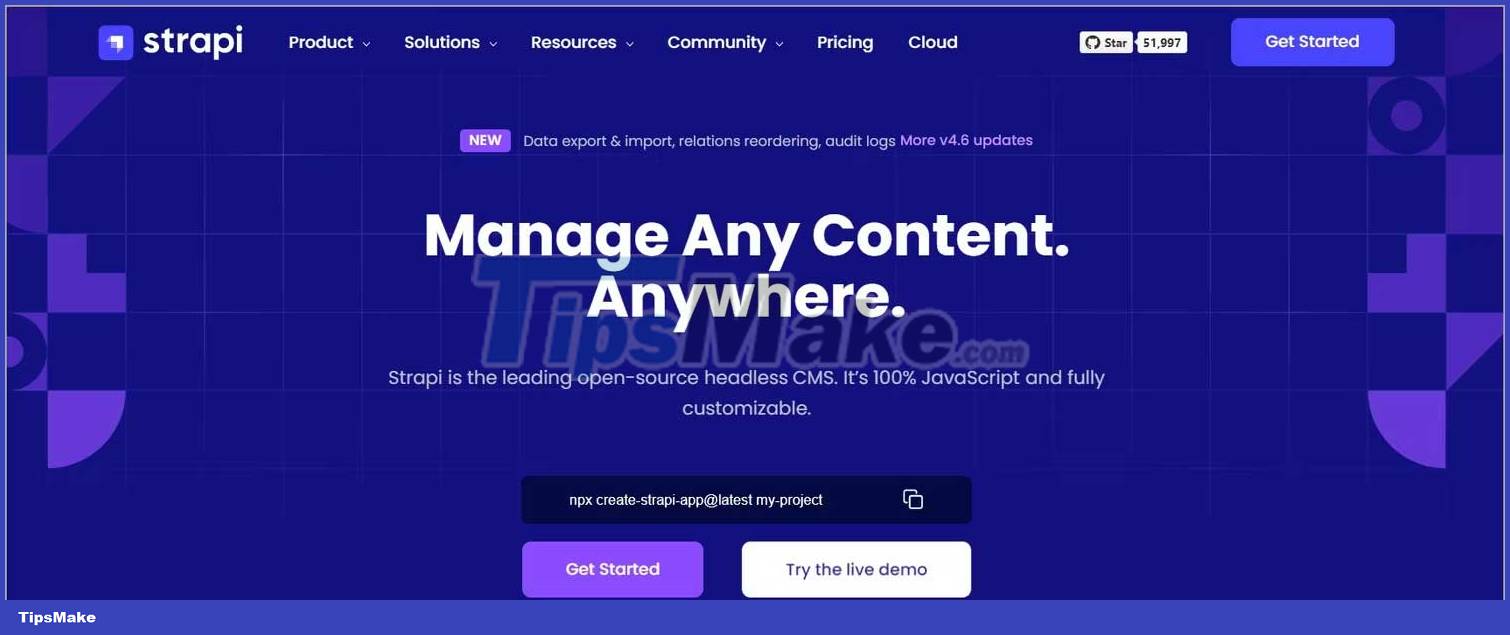Best Open Source Headless CMS for JavaScript Apps

In order to help you make the right decision, the article will summarize the 3 best rated headless CMS today. You will know the key features and benefits of using them to make the best choice for your project.
Factors to consider when choosing a CMS
- Ease of use : Whether a CMS is easy to use or not depends on the user. This can be challenging if you choose a headless CMS that lacks a UI to view or edit content. To fix it, you can create a simple UI that integrates with the headless CMS. This also makes it easier for inexperienced people to work with it.
- Price : Before choosing a CMS, check if it's free or the price is right for your budget.
- Available Integrations : When choosing a CMS, it is important to consider the possibility of integrating it with other tools in your 'tech stack'. For example, confirm which CMS can connect to your page builder, email marketing platform, or analytics tool. Also, you should also check if the CMS has good integration documentation.
- Collaborative support : Content is often handled in teams. A good CMS allows members to work directly together to streamline workflow.
- API Support : CMS communicates with front end via APK. Each CMS supports its own API, which is not the same. Please select the API you want.
3 most popular open source headless CMS
Netlify CMS
Netlify CMS is an open source content management system, built specifically for static sites. It is based on Git, allowing you to store content along with code. This feature makes it easy to version your content and track changes.

Netlify CMS
Main features of Netlify CMS
- Netlify CMS features an easy-to-use UI with real-time preview, drag & drop for media upload, and a rich text editor.
- It has detailed documentation and beginner templates written with technology like Hugo, Gatsby, Next.js, and Eleventy that help you set up a site in no time.
- With Git Gateway, an open source Netlify project, you can add editors to CMS without giving them access to the Git repository.
- Netlify CMS is built with client-side JavaScript, making it faster and easier to scale.
- It supports several content types including Markdown, JSON, YAML or TOML files.
- If you don't want to save your content on GitHub, you can connect a custom backend to the Netlify CMS.
- Netlify CMS provides a global object named Window.cms. You can use it to create custom plugins, previewers, and widgets.
- NetlifyCMS is the perfect choice for blog development. You can get started with one of the free templates available on the platform.
Medusa

Medusa
Medusa is a completely free and open source CMS. It allows you to easily add commercial functionality to your application.
Medusa supports various payment platforms like Stripe, Paypal and Klarma, and search engines like Algolia, Meilisearch, analytics and marketing tools like Segment. This decoupled approach gives you the freedom to use the tools that are best suited for the app under development.
Main features of Medusa
- Detailed, extensive documentation is developed using JavaScript frameworks such as Next.js and Gatsby.js.
- Users who are not very tech-savvy can also edit and add content to the web like Medusa Admin UI.
- Enables integration of analytical processing, billing, media storage, search and notification tools.
- Allows you to add users to the Admin UI. Users only need email and password to login.
- Flexible and allows you to build a custom application from scratch using the technologies and tools of your choice.
- Multi-language and multi-currency support. You can create regions containing one or more countries with an e-commerce app. These regions will determine the currency, language and tax rates.
Medusa is a great choice for building an e-commerce app.
Strapi
 Strapi
Strapi
Strapi is a headless CSS based on Node.js and the richest CMS. It is flexible and allows you to deliver content across any app, including web, mobile, and voice.
Strapi has plugins that you can use to extend the functionality of the Strapi app. You can also create plugins to meet specific needs, customize the resolver, and extend the GraphQL style schema.
Main features of Strapi
- Strapi is self-hosted, giving you the freedom to store apps where you want. You can host it on your personal servers or on BaaS platforms like AWS, Digital Ocean, Microsoft Azure, and Heroku.
- Supports several SQL databases such as MySQL, PostgreSQL and SQLite.
- Supports both REST and GraphQL APIs. It all depends on how you want to query the data.
- Rich documentation, examples, tutorials and easy-to-follow starter projects. It also has a great community resource. Here you can get answers while building your app.
- For the content team, Strapi has a built-in editor panel that allows for different types of media uploads, including photos and videos. It also supports collaboration and role-based access control.
- Strapi works well with modern frameworks like Next.js, Gatsby, Angular, and Vue.
- Strapi is open source. The Community Edition will always be free to use. It is a great choice if you are looking for a fully customizable CMS.
Above are the most popular headless CMS and their outstanding features. Hope the article is useful to you.
You should read it
- Important factors when choosing a TV screen to watch the 2018 World Cup
- Shop for a laptop with a tight budget
- Set up Query Criteria in Access 2016
- Alternate Criteria in Access 2016
- How to choose medical wheelchairs for the elderly and patients
- Top criteria when choosing to buy air conditioner
- How to invert a selection in Photoshop
- 4 methods to create the best selection in Photoshop
May be interested
- What is source code? Learn about Source Code
 source code or open source are probably terms you see often, such as open source games or open source software. so what exactly is source code, what is source code, what is open source code and what is closed source code? we will find the answer together through the article below.
source code or open source are probably terms you see often, such as open source games or open source software. so what exactly is source code, what is source code, what is open source code and what is closed source code? we will find the answer together through the article below. - What is JavaScript? Can the Internet exist without JavaScript?
 not everyone knows what javascript is and how it works. the long and fascinating development history of javascript as well as what we can do with javascript is still unknown.
not everyone knows what javascript is and how it works. the long and fascinating development history of javascript as well as what we can do with javascript is still unknown. - JavaScript code that generates box and whisker charts containing outliers
 the example below illustrates a box & whisker chart pattern with outlier values represented by a scatter plot. the article also provides javascript source code for you to edit or save to your computer to run internally.
the example below illustrates a box & whisker chart pattern with outlier values represented by a scatter plot. the article also provides javascript source code for you to edit or save to your computer to run internally. - JavaScript code to generate dynamic line graphs/charts
 the example below illustrates a line chart template created with javascript. it updates data every 500 milliseconds. the article also provides source code for you to edit in the browser or save to your computer to run locally.
the example below illustrates a line chart template created with javascript. it updates data every 500 milliseconds. the article also provides source code for you to edit in the browser or save to your computer to run locally. - Cisco Linksys WRT160NL - 'toy' specifically for open source people
 being open-source who likes to use toxic goods, mr. nguyen scoured the place to find an open-source wi-fi device.
being open-source who likes to use toxic goods, mr. nguyen scoured the place to find an open-source wi-fi device. - What is the difference between open source software and closed source software?
 everything you see on the screen includes the language. someone wrote down words for your computer to understand. these words, or languages, are called codes.
everything you see on the screen includes the language. someone wrote down words for your computer to understand. these words, or languages, are called codes. - Thousands of iOS apps could be at risk because of an open source vulnerability
 a vulnerability in open source software cocoapods can put applications such as facebook, tiktok, netflix on ios and macos at risk of attack.
a vulnerability in open source software cocoapods can put applications such as facebook, tiktok, netflix on ios and macos at risk of attack. - JavaScript code to generate box and whisker charts/graphs
 the example below illustrates a box and whisker chart/graph template created with javascript. the article also provides the source code for you to edit in the browser and save to your computer to run locally.
the example below illustrates a box and whisker chart/graph template created with javascript. the article also provides the source code for you to edit in the browser and save to your computer to run locally. - What is Currying in Javascript? How to use Currying in JavaScript
 the currying feature in javascript can help you keep your code tidy and give you a new way of seeing how functions work. currying is ideal when you want to break complex logic into smaller, manageable, and self-contained pieces of code.
the currying feature in javascript can help you keep your code tidy and give you a new way of seeing how functions work. currying is ideal when you want to break complex logic into smaller, manageable, and self-contained pieces of code. - Things to know about 'this' in JavaScript
 are you having trouble understanding the keyword 'this' in javascript ? then please read what you need to know about 'this' in javascript below.
are you having trouble understanding the keyword 'this' in javascript ? then please read what you need to know about 'this' in javascript below.










 How to automate Vlookup with Excel VBA
How to automate Vlookup with Excel VBA Rust - A programming language created by a broken elevator, can 'surpass' both C and C ++
Rust - A programming language created by a broken elevator, can 'surpass' both C and C ++ How to convert any website into a Figma design
How to convert any website into a Figma design How to graph trigonometric functions with Excel
How to graph trigonometric functions with Excel 5 Best IDEs for Programming on Windows 10
5 Best IDEs for Programming on Windows 10 Web13: Session Hijacking Hacking Techniques
Web13: Session Hijacking Hacking Techniques